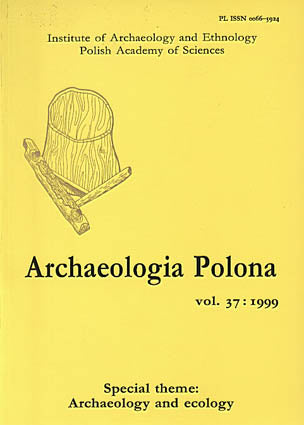Archaeologia Polona vol. 37:1999 Special Theme: Archaeology and Ecology
15,00 $
Description: 167 pages, drawings, photos,
Condition: very good
Weight: 320g.
Archaeologia Polona vol. 37:1999 Special Theme: Archaeology and Ecology, Institute of Archaeology and Ethnology Polish Academy of Sciences, Warsaw 1999
Editorial
Neolithic penetration of European Mid Mountains
Pawel Valde-Novak Identifying a Bronze Age landscape - ideology and settlement organisation in a southwestern Swedish river valleyore Artelius The shell-midden sites of RHj AND RH6 (Muscat, Sultanate of Oman) in
their environmental setting
Paolo Biagi and Renato Nisbet Society and the environment. A case study of Early Bronze Age settlement complex from Rybiny, Kujawy, Poland
Przemjsiaiv Makarouic and Krystyna Milecka Environmental reasons of migrations of the South-East Europe population in the ist jth centuries A.D.
A.M. Oblomski, 0. V. Petrauskas and R. V. Terpilovski Early medieval wells from Pfettrach in Bavaria: cultural ecology of an early Bavarian village
Bernd Tingelhardt, Dariusz Krasnodebski, Mirosiaiva Kupryjanoivicz and Maria Michniewicz North Atlantic turf architecture as an example of environmental adaptation
Przemyslaw Urbanczyk The medieval castle Lanzenkirchen in Lower Austria: reconstruction of
economical and ecological development of an average-sized manor
(12th- 15th century)
Thomas Kiihtreiber Economy and environment ? contribution to the birth of medieval town in Pultusk
Andrzej Golembnik Archaeological sites as national monuments - two examples from Sweden
Gustav Trotzig
Relationships between archaeology and ecology arc obvious and multiaspcc-tual. Archaeological sites, besides the data on prehistoric technologies, economics or social relationships, encompass also enormous resources of environmental data, enabling the reconstruction of natural landscape, which had determined human activities in the past and which people had actively transformed, making it suitable for their needs. Analysis of these data can bring deeper understanding of economic, cultural and social changes in prehistory and early history. It is therefore obvious that an archaeologist cannot ignore the presence of these data in his or her attempt to describe and understand history of humankind.
At the same time the relationships between archaeology and ecology have also other, less frequently realized aspect. Archaeological sites, which have survived to our times, became themselves part of our contemporary cultural environment. How to protect and preserve these elements of our cultural landscape, how they influence our life and how can we use them for the benefit of general public - these questions also should be answered by archaeology.
The present volume takes its beginning with the international conference, which was held in 1997 at Biclsk Podlaski - little town in the eastern part of Poland. The place to hold this conference was chosen deliberately: the north?eastern part of Poland is a region where natural landscape is still only minimally transformed by man, region where enormous areas of forests, non-regulated bogs and meadows survived. Visiting this part of the country it is possible to imagine the original environmental conditions in which cultures and civilizations developed in the past?

